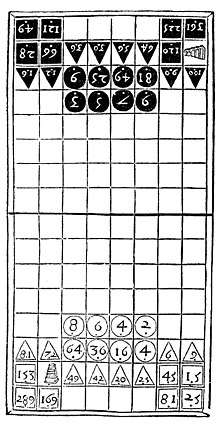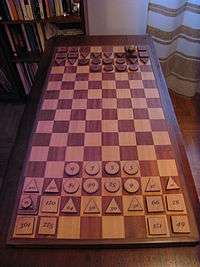Rithmomachy
Rithmomachy (or Rithmomachia, also Arithmomachia, Rythmomachy, Rhythmomachy, or sundry other variants; sometimes known as The Philosophers' Game) is a highly complex, early European mathematical board game. The earliest known description of it dates from the eleventh century. A literal translation of the name is "The Battle of the Numbers". The game is much like chess, except most methods of capture depend on the numbers inscribed on each piece.

It has been argued that between the twelfth and sixteenth centuries, "rithmomachia served as a practical exemplar for teaching the contemplative values of Boethian mathematical philosophy, which emphasized the natural harmony and perfection of number and proportion. The game, Moyer argues, was used both as a mnemonic drill for the study of Boethian number theory and, more importantly, as a vehicle for moral education, by reminding players of the mathematical harmony of creation."[1]
History
Very little, if anything, is known about the origin of the game. But it is known that medieval writers attributed it to Pythagoras, although no trace of it has been discovered in Greek literature, and the earliest mention of it is from the time of Hermannus Contractus (1013–1054).
The name, which appears in a variety of forms, points to a Greek origin, the more so because Greek was little known at the time when the game first appeared in literature. Based upon the Greek theory of numbers, and having a Greek name, it is still speculated by some that the origin of the game is to be sought in the Greek civilization, and perhaps in the later schools of Byzantium or Alexandria.
The first written evidence of Rithmomachia dates back to around 1030, when a monk, named Asilo, created a game that illustrated the number theory of Boëthius' De institutione arithmetica, for the students of monastery schools. The rules of the game were improved shortly thereafter by the respected monk, Hermannus Contractus, from Reichenau, and in the school of Liège. In the following centuries, Rithmomachia spread quickly through schools and monasteries in the southern parts of Germany and France. It was used mainly as a teaching aid, but, gradually, intellectuals started to play it for pleasure. In the 13th century Rithmomachia came to England, where famous mathematician Thomas Bradwardine wrote a text about it. Even Roger Bacon recommended Rithmomachia to his students, while Sir Thomas More let the inhabitants of the fictitious Utopia play it for recreation.
The game was well enough known as to justify printed treatises in Latin, French, Italian, and German, in the sixteenth century, and to have public advertisements of the sale of the board and pieces under the shadow of the old Sorbonne.

Gameplay
The game was played on a board resembling the one used for chess or checkers, with eight squares on the shorter side, but with sixteen on the longer side. The forms used for the pieces were triangles, squares, and rounds. Pyramids could be formed by stacking pieces. The game was noteworthy in that the black and white forces were not symmetrical. Although each side had the same array of pieces, the numbers on them differed, allowing different possible captures and winning configurations to the two players.
The rules below describe the most common version of the game, played through much of the Middle Ages and Renaissance. There was also a variant propounded by Fulke in the 16th century, with significantly different (and somewhat more consistent) capture rules.[2]
Pieces
There are four types of pieces, which are Rounds, Triangles, Squares, and Pyramids.
- Rounds: Rounds move one square in any of the four diagonals.
- Triangles: Triangles can move exactly two squares vertically or horizontally, but not diagonally.
- Squares: Squares can move exactly three squares vertically or horizontally, but not diagonally.
- Pyramids: Pyramids are not actually one piece, but more than one piece put together. The White Pyramid is made of a "36" Square, a "25" Square, a "16" Triangle, a "9" Triangle, a "4" Round, and a "1" Round, which totals up to the Pyramid's value of 91. The Black Pyramid is made up of a "64" Square, a "49" Square, a "36" Triangle, a "25" Triangle, and a "16" Round, which adds up to the Pyramid's value of 190. These irregular values make it hard for them to be captured by most of the capturing methods listed below, except for Siege. Pyramids can move like a Round, a Triangle, or a Square, as long as they still contain the respective piece, which makes them very valuable.
Capturing
There were a variety of capture methods. Pieces do not land on another piece to capture it, but instead remain in their square and remove the other. If a piece is captured, it changes sides.[3]
- Meeting: If a piece could capture another piece with the same value by landing on it, the piece stays in its location and the opponent's piece is taken from the board.
- Assault: If a piece with a small value, multiplied by the number of vacant spaces between it and another larger piece is equal to the larger piece, the larger piece is captured.
- Ambuscade: If two pieces' sum is equal to an enemy piece that is placed between the two (i.e. the enemy piece is within a move of both attacking pieces), the enemy piece is captured and removed from the board.
- Siege: If a piece is surrounded on all four sides, it is removed.
Victory
There were also a variety of victory conditions for determining when a game would end and who the winner was. There were common victories, and proper victories, which were recommended for more skilled players. Proper victories required placing pieces in linear arrangements in the opponent's side of the board, with the numbers formed by the arrangement following various types of numerical progression. The types of progression required — arithmetic, geometric and harmonic — suggest a connection with the mathematical work of Boëthius.
- Common Victories:
- De Corpore (Latin: "by body"): If a player captures a certain number of pieces set by both players, they win the game.
- De Bonis ("by goods"): If a player captures enough pieces to add up to or exceed a certain value that is set by both players, they win the game.
- De Lite ("by lawsuit"): If a player captures enough pieces to add up to or exceed a certain value that is set by both players, and the number of digits in their captured pieces' values are less than a number set by both players, they win the game.
- De Honore ("by honour"): If a player captures enough pieces to add up to or exceed a certain value that is set by both players, and the number of pieces they captured are less than a certain number set by both players, they win the game.
- De Honore Liteque ("by honour and lawsuit"): If a player captures enough pieces to add up to or exceed a certain value that is set by both players, the number of digits in their captured pieces' values are less than a number set by both players, and the number of pieces they captured are less than a certain number set by both players, they win the game.
- Proper Victories:
- Victoria Magna ("great victory"): This occurs when three pieces that are arranged are in an arithmetic progression.
- Victoria Major ("greater victory"): This occurs when four pieces that are arranged have three pieces that are in a certain progression, and another three pieces that are in another type of progression.
- Victoria Excellentissima ("most excellent victory"): This occurs when four pieces that are arranged have all three types of mathematical progressions in three different groups.
Popularity
At its peak, Rithmomachy rivalled chess for popularity in Europe. The game virtually disappeared from the 17th century until the late 19th and early 20th century, when it was rediscovered by historians.
References
- Sepkoski 698
- Fulke, "Of these partes in the fyrst kynd of playng"
- Suzuki, Jeff (2009). Mathematics in Historical Context. Mathematical Association of America. p. 144. ISBN 978 0 88385 570 6.
Bibliography
- Menso Folkerts, Die «Rithmachia» des Werinher von Tegernsee, in M. Folkerts - J. P. Hogendijk, Vestigia mathematica: Studies in Medieval and Early Modern Mathematics in Honour of H.L.L. Busard, Amsterdam 1993, pp. 107-142
- R. C. Bell, The Boardgame Book, p. 136, ISBN 0-671-06030-9
- Arno Borst, Das mittelalterliche Zahlenkampfspiel, ISBN 3-8253-3750-2
- Jean-Louis Cazaux and Rick Knowlton, A World of Chess: Its Development and Variations Through Centuries and Civilizations, ISBN 978-0786494279
- Underwood Dudley, Numerology, or What Pythagoras Wrought, Chapter 17, Mathematical Association of America, ISBN 0-88385-524-0
- Ann E. Moyer, The Philosopher's Game, University of Michigan Press, ISBN 0-472-11228-7
- David Sepkoski, “Ann E. Moyer: The Philosopher’s Game: Rithmomachia in Medieval and Renaissance Europe.” Isis, Vol. 95, No. 4 (December 2004), pp. 697–699.
- Joseph Strutt and J. Charles Cox, Strutt's Sports & Pastimes of the People of England, pp.254–5
- David Parlett, The Oxford History of Board Games, pp. 332–342, ISBN 0-19-212998-8
- Jean-Marie Lhôte, Histoire des jeux de société, pp. 201 & 598-9, ISBN 2-08-010929-4
- William Fulke (1563), translating Boissiere (1556), The Most Noble, ancient and learned playe, called the Philosopher's Game, STC 15542a. Online transcription
External links
| Wikimedia Commons has media related to Rithmomachia. |